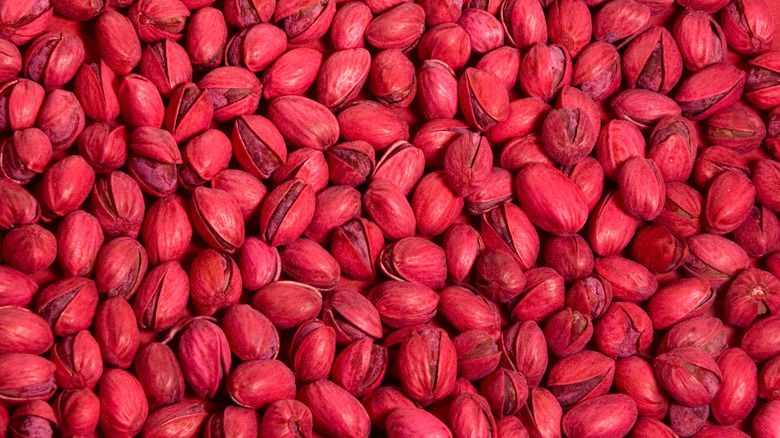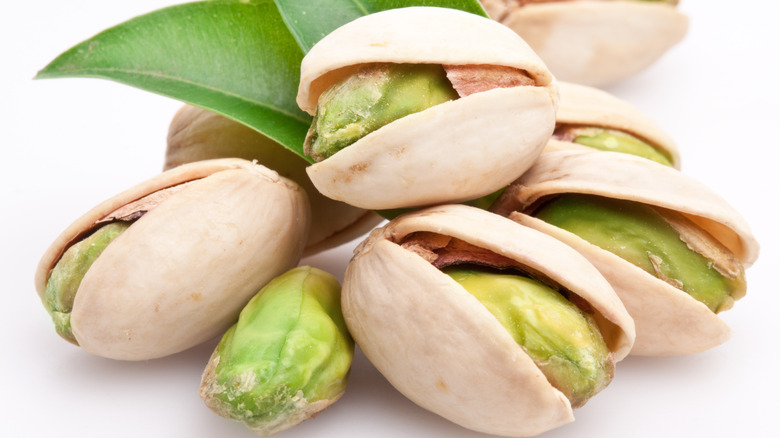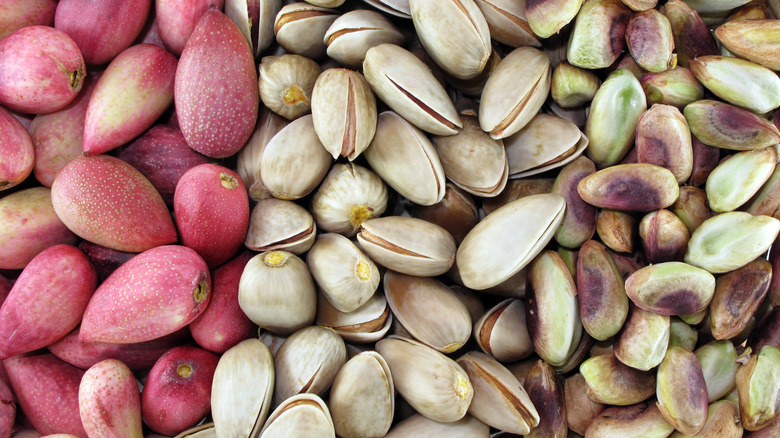The Almost-Forgotten Era Of Red Pistachios
If you're under the age of 40, you may not remember red pistachios. Red pistachios aren't some sort of exotic variety of the tan-shelled nut we eat today. Instead, they are the result of an obsolete practice of coloring pistachio shells with artificial food dye. Many people remember how snacking on them could leave you red-handed, and if you need proof of the dye's incredible ability to stain, check out this classic scene from the movie "Naked Gun."
Pistachio shells have a red hue when they're growing on the tree. The exterior changes color after harvesting and the nut inside has a greenish tint, but none naturally sport the bright red shells seen in the past.
When and why did people begin to dye pistachio shells? The history behind it is unclear but that doesn't keep urban legends from continuing to spread. The internet is full of theories and stories about the formerly bright red snack.
A confusing history
One theory behind why pistachios were dyed red has to do with marketing. As the story goes, before the 1980s, most pistachios in the U.S. were imported from Iran. Iranian producers had outdated equipment and methods that left the shells bruised and unappealing, so they dyed them to cover the imperfections.
However, the California Pistachio Commission, as quoted in the LA Times, says the story is nuts, and they were dyed for an entirely different reason. Their version of the story says pistachios were dyed after they arrived in the U.S., not in Iran, and they were colored to make them more eye-catching to the consumer.
More controversial history surrounds the reason why producers stopped dyeing pistachio shells. According to HuffPost, the U.S. continued to import the nut from Iran until more than 50 Americans were taken hostage in 1979 in Iran, at which point the U.S. imposed embargoes against all Iranian imports — including pistachios. The embargo forced California growers to step up to the plate, and since their harvesting and processing systems were superior to the Iranian methods, the shells did not need to be dyed.
However, according to the Washington Post, there's no correlation. It takes ten years for a tree to produce nuts, so it would have been impossible for the California growers to replace the Iranian imports so quickly. Luckily, pistachio growing in California had already been amping up before the hostage crisis, and growers quickly met the demand.
Food dye concerns
It's hard to know which version of the history of red pistachios is true, but it's probably no coincidence that artificial food dyes started to come under scrutiny around the same time the practice stopped. Red dye #3 had been banned in the late '70s, giving all food dyes a bad reputation (per Smithsonian). Even though the nut inside was not dyed, the vibrant red of the shell looked unnatural and potentially unhealthy.
Today, the majority of pistachios sold in the U.S. come from California — the San Joaquin Valley has the dry climate the trees need to flourish — but many are now produced in Arizona and New Mexico as well. Between 2021-2022, the U.S. produced 67% of the world's pistachios (via World Population Review).
Pistachios are one of the more expensive nuts on the market. The trees take longer to produce, and harvesting the nut is more complicated than other nuts (via Farm Progress). They're worth the money, however, and if you're feeling nostalgic, you can shell out cash and buy red pistachios. Some companies still sell them and they could be the perfect snack for National Pistachio Day.


